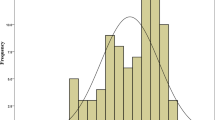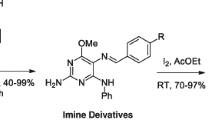Abstract
Pneumocystis carinii is a nonpathogenic fungus found in respiratory tract of healthy humans. It is a major cause of death in AIDS patients. P. carinii dihydrofolatereductase inhibitors such as trimetrexate are currently used to treat P. carinii pneumonia. These drugs have several adverse side effects and, therefore, there is a critical need for the identification of novel dihydrofolatereductase inhibitors. In this work, quantitative structure – activity relationship models were derived for 395 stucturally diverse P. carinii dihydrofolatereductase inhibitors. A wide variety of molecular descriptors belonging to various structural properties were calculated for each molecule. Both linear (multiple linear regression) and non-linear (generalized regression neural network) models were developed to link the calculated descriptors as independent variables to their reported biological activity as dependent variable. Different variable transformation was performed on the both dependent and independent variables to obtain better multiple linear regression models. At first glance, it seemed applying variable transformation on the dependent variable was necessary to improve quality of the quantitative structure–activity relationships models because it made the model more predictive. Upon further inspection, the results were not necessarily surprising. In the other words, back-transforming predictions did not give unbiased estimations of pIC50. At the final trial, generalized neural network was employed to develop predictive quantitative structure–activity relationships model.









Similar content being viewed by others
References
Abbasitabar F, Zare-Shahabadi V (2012) Development predictive QSAR models for artemisinin analogues by various feature selection methods: a comparative study. SAR QSAR Environ Res 23(1-2):1–15. doi:10.1080/1062936x.2011.623316
Agrawal VK, Sohgaura R, Khadikar PV (2002) QSAR studies on biological activity of piritrexim analogues against pc DHFR. Biorg Med Chem 10(9):2919–2926. doi: 10.1016/S0968-0896(02)00159-1
Akhlaghi Y, Kompany-Zareh M (2006) Application of radial basis function networks and successive projections algorithm in a QSAR study of anti-HIV activity for a large group of HEPT derivatives. J Chemom 20(1–2):1–12. doi:10.1002/cem.971
Baumann D, Baumann K (2014) Reliable estimation of prediction errors for QSAR models under model uncertainty using double cross-validation. J Cheminform 6(1):47, 10.1186/s13321-014-0047-1
Baumann K (2005) Chance correlation in variable subset regression: influence of the objective function, the selection mechanism, and ensemble averaging. QSAR Comb Sci 24(9):1033–1046. doi:10.1002/qsar.200530134
Bhabha G, Lee J, Ekiert DC, Gam J, Wilson IA, Dyson HJ, Benkovic SJ, Wright PE (2011) A dynamic knockout reveals that conformational fluctuations influence the chemical step of enzyme catalysis. Science 332(6026):234–238. doi:10.1126/science.1198542
ChemDraw Ultra 6.0 and Chem3D Ultra, Cambrige Coft Corporation, CambridgePlease provide complete details for the reference ChemDraw Ultra 6.0 and Chem3D Ultra.
Debnath B, Vishnoi SP, Sa B, Jha T (2003) QSAR study on some dihydrofolate reductase inhibitors. Internet Electron J Mol Des 2(3):128–136
Draper NR, Smith H (1998) Applied regression analysis, 3rd edn. Wiley, New York
Galvão RKH, Araujo MCU, José GE, Pontes MJC, Silva EC, Saldanha TCB (2005) A method for calibration and validation subset partitioning. Talanta 67(4):736–740. doi:10.1016/j.talanta.2005.03.025
Gangjee A, Adair O, Queener SF (2001) Synthesis of 2,4-diamino-6-(thioarylmethyl)pyrido[2,3-d]pyrimidines as dihydrofolate reductase inhibitors. Biorg Med Chem 9(11):2929–2935. doi: http://dx.doi.org/10.1016/S0968-0896(01)00223-1
Gangjee A, Elzein E, Queener SF, McGuire JJ (1998) Synthesis and biological activities of tricyclic conformationally restricted tetrahydropyrido annulated furo[2,3-d]pyrimidines as inhibitors of dihydrofolate reductases. J Med Chem 41(9):1409–1416. doi:10.1021/jm9705420
Gangjee A, Lin X (2005) CoMFA and CoMSIA analyses of Pneumocystis carinii dihydrofolate reductase, Toxoplasma gondii dihydrofolate reductase, and rat liver dihydrofolate reductase. J Med Chem 48(5):1448–1469. doi:10.1021/jm040153n
Gangjee A, Shi J, Queener SF (1997) Synthesis and biological activities of conformationally restricted, tricyclic nonclassical antifolates as inhibitors of dihydrofolate reductases. J Med Chem 40(12):1930–1936. doi:10.1021/jm960693n
Gready JE (1980) Dihydrofolate reductase: binding of substrates and inhibitors and catalytic mechanism. Adv Pharmacol Chemother 17:37–102
Guha R, Jurs PC (2004) Development of QSAR models to predict and interpret the biological activity of artemisinin analogues. J Chem Inf Comput Sci 44(4):1440–1449. doi:10.1021/ci0499469
Jain P, Soni LK, Gupta AK, Kashkedikar SG (2005) QSAR analysis of 2,4-diaminopyrido[2,3-d]pyrimidines and 2,4-diaminopyrrolo[2,3-d]pyrimidines as dihydrofolate reductase inhibitors. Indian J Biochem Biophys 42:315–320
Jalali-Heravi M, Ebrahimi-Najafabadi H, Khodabandehloo A (2009) Use of kernel orthogonal projection to latent structure in modeling of retention indices of pesticides. QSAR Comb Sci 28(11–12):1432–1441. doi:10.1002/qsar.200910072
Kompany-Zareh M (2009) An improved QSPR study of the toxicity of aliphatic carboxylic acids using genetic algorithm. Med Chem Res 18(2):143–157. doi:10.1007/s00044-008-9114-3
Manchester J, Czermiński R (2008) SAMFA: simplifying molecular description for 3D-QSAR. J Chem Inf Model 48(6):1167–1173. doi:10.1021/ci800009u
Mattioni BE, Jurs PC (2003) Prediction of dihydrofolate reductase inhibition and selectivity using computational neural networks and linear discriminant analysis. J Mol Graph Model 21(5):391–419. doi: http://dx.doi.org/10.1016/S1093-3263(02)00187-0
Mosier PD, Jurs PC (2002) QSAR/QSPR studies using probabilistic neural networks and generalized regression neural networks. J Chem Inf Comput Sci 42(6):1460–1470. doi:10.1021/ci020039i
Rosowsky A, Hynes JB, Queener SF (1995) Structure-activity and structure-selectivity studies on diaminoquinazolines and other inhibitors of Pneumocystis carinii and Toxoplasma gondii dihydrofolate reductase. Antimicrob Agents Chemother 39(1):79–86. doi:10.1128/aac.39.1.79
Santos-Filho O, Forge D, Hoelz LB, Freitas GL, Marinho T, Araújo J, Albuquerque M, Alencastro R, Boechat N (2012) CoMFA/CoMSIA 3D-QSAR of pyrimidine inhibitors of Pneumocystis carinii dihydrofolate reductase. J Mol Model 18(9):4061–4072. doi:10.1007/s00894-012-1399-y
Santos-Filho OA, Cherkasov A (2008) Using molecular docking, 3D-QSAR, and cluster analysis for screening structurally diverse data sets of pharmacological interest. J Chem Inf Model 48(10):2054–2065. doi:10.1021/ci8001952
Schweitzer BI, Dicker AP, Bertino JR (1990) Dihydrofolate reductase as a therapeutic target. FASEB J 4(8):2441–2452
Shamsipur M, Zare-Shahabadi V, Hemmateenejad B, Akhond M (2009) An efficient variable selection method based on the use of external memory in ant colony optimization. Application to QSAR/QSPR studies. Anal Chim Acta 646(1-2):39–46. doi:10.1016/j.aca.2009.05.005
Sutherland JJ, O’Brien LA, Weaver DF (2004) A comparison of methods for modeling quantitative structure−activity relationships. J Med Chem 47(22):5541–5554. doi:10.1021/jm0497141
Sutherland JJ, Weaver D (2004) Three-dimensional quantitative structure−activity and structure−selectivity relationships of dihydrofolate reductase inhibitors. J Comput Aided Mol Des 18(5):309–331. doi:10.1023/B:JCAM.0000047814.85293.da
Topological Indices and Related Descriptors in QSAR and QSPAR (2000) Gordon & Breach, AmsterdamPlease provide book title for the reference Topological Indices and Related Descriptors in QSAR and QSPAR (2000).
Zare-Shahabadi V, Abbasitabar F (2010) Application of ant colony optimization in development of models for prediction of anti-HIV-1 activity of HEPT derivatives. J Comput Chem 31(12):2354–2362. doi:10.1002/jcc.21529
Zare-Shahabadi V, Lotfizadeh M, Gandomani ARA, Papari MM (2013) Determination of boiling points of azeotropic mixtures using quantitative structure–property relationship (QSPR) strategy. J Mol Liq 188(0):222–229. doi: http://dx.doi.org/10.1016/j.molliq.2013.09.037
Zhu J, Lu W, Liu L, Gu T, Niu B (2009) Classification of Src kinase inhibitors based on support vector machine. QSAR Comb Sci 28(6-7):719–727. doi:10.1002/qsar.200860105
Acknowledgements
The author thanks Prof. Knut Baumann for fruitful help and advice. Financial assistance from the Islamic Azad University-Mahshahar Branch is gratefully acknowledged. This paper was extracted froma research project entitled ‘QSAR study of dihydrofolatereductase inhibitors activities’.
Author information
Authors and Affiliations
Corresponding author
Ethics declarations
Conflict of interest
The authors declare that they have no competing interests.
Electronic supplementary material
Rights and permissions
About this article
Cite this article
Zare-Shahabadi, V. Quantitative structure–activity relationships of dihydrofolatereductase inhibitors. Med Chem Res 25, 2787–2797 (2016). https://doi.org/10.1007/s00044-016-1666-z
Received:
Accepted:
Published:
Issue Date:
DOI: https://doi.org/10.1007/s00044-016-1666-z




